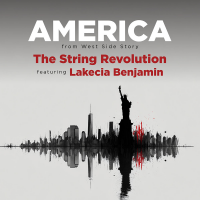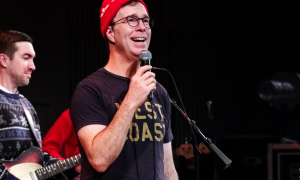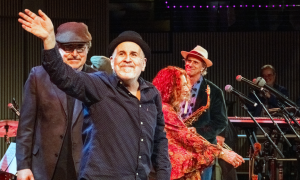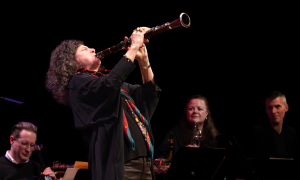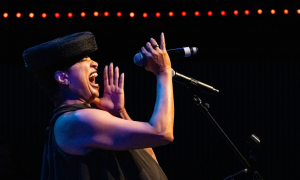Home » Jazz Articles » Live Review » NYC Winter Jazzfest, Day 2: January 7, 2012
NYC Winter Jazzfest, Day 2: January 7, 2012
2012 NYC Winter Jazzfest, Day 2
New York, NY
January 7, 2012
Gregoire Maret
The harmonica, like the accordion and other free reed aerophones, doesn't come with as much built-in room for expression as other wind instruments, which is what makes Gregoire Maret's playing so unique. For his quartet show at Zinc Bar, Maret relied on loose melodicism, carefully organized ornaments and just the right amount of "out" playing to give his playing the necessary amount of personal style. Amidst soulful jazz, the chromatic harmonica tends to recall Stevie Wonder and while Maret's melodies certainly hinted at Wonder's inflection, he was easily adept at shredding, pulling down lively and impassioned bebop-based lines that would usually be found in a Joe Henderson or early Wayne Shorter solo. Lest they forget the power of the melodica, Maret reminded the audience just what he was capable of at the climax of a solo with several two-note harmonies like a piano would do.
Maret's music for quartet had both an optimistic and melancholy quality to it, drawing from jazz, soul and Latin music. The emotional quality of his compositions became more important than the devices they used—as an example, the barely noticeable use of 7/4 time in more than one of his compositions. Some of Maret's music was based around episodes, like one composition that segued out of a modern jazz groove into a march that settled itself around a pulsating piano texture. The other members of the quartet bolstered Maret's music: Ben Williams provided elegant, singing melodies on electric bass, Federico Gonzalez Pena created joyous, dancing melodies in the middle of the piano and the ever-versatile Clarence Penn supplied both wide-ranging cymbal color and drum rhythms that got more intense as the night went on, percolating to a satisfying finish.
Lionel Loueke
There is something about guitarist Lionel Loueke's blend of West African/Beninese music with jazz that avoids the dreaded "fusiony" sound that was so very beaten-to-death in the 90's-late 2000's. Loueke's trio set during the festival might have provided some clues. It could have been his willingness to embrace jazz's extremely adventurous harmonic sense in the context of more native music, wherein he laid out his Leslie-powered soul guitar sound and injected it with obtuse, darting lines. It could also have been that his use of wordless vocals went deeper than a Bobby McFerrin impersonation, using a vocal harmonizer and other electronics to create a one-man-chorus approach to lyricism (both figuratively and literally). One component that definitely brought his music out of the typical world music framework was his use of sidemen. Electric bassist Michael Olatuja acted as both a pocket master and a 4-stringed cousin to some of Loueke's more classical-guitar-style solos, and Mark Giuliana applied his usual twists in timekeeping and drum coloration combinations.
Whatever the explanation may be, Loueke, like many other skilled musicians on the jazz scene, exhibited a strongly personal sound using different musical attributes. His music seemed to toggle between two modes, one being a grooving percussiveness accentuated by the pops and thumps of Loeuke's voice and guitar, the other a much quieter ballad sensibility. In the latter, Loueke used slowly strummed and cycling chords in tandem with a wordless melody on "Wida," a tribute to a village in Benin. Some of his comping was extremely sparse, only eking out a few tones for Olatuja's mobile bass solo. Much like Maret's set, though, Loueke's set was well paced and finished with a final flourish of Giuliana's signature mathematical beat music.
Vijay Iyer Trio
Iyer's trio is one of the few working ensembles that has exhibited collective growth as a singular unit. At Le Poisson Rouge, Iyer showed that he continuously expands his color palette as a pianist, a trait that served the trio more than it served himself. Stephan Crump's textures as a bassist (ranging from rounded to sliding notes that suggest a synthesizer sound, to scratchy, against-the-bridge textures) more thoroughly contributed to the trio's eclecticism than ever before. Marcus Gilmore played the living "the drum sample" in Iyer's music, a demanding role that required him to operate in muted drum textures, irregular grooves and fluttering bombast. Therein lies the immediately recognizable sound of the Vijay Iyer trio, one that pulled no punches at Winter Jazzfest.
Iyer has acquired a Sonny Rollins-esque taste for unusual source material and the way he executed every piece probably inspired many an audience member to start crate digging. Iyer's interpretation of Heatwave's 1978 funk tune "Star of the Story" found Iyer melting his stacked chordal intro into hypnotic and repetitive power chords with his left hand, while Crump's bowed bass imitated the orchestral aspect of the original. The trio's take on Michael Jackson's "Human Nature" was a more triumphant and collaborative take on the tune than Iyer's solo piano. Iyer played the chorus ever so slightly out of time and when the band accentuated the underlying pulse, they didn't vamp so much as they deconstructed their own rhythmic set-up.
Iyer's original compositions traced out his vision of a unifying musical future, one where acoustic, electronic, sampled and re-sampled sounds mix into one. On "Lude," Iyer navigated a continuous dialogue between dark left-hand thumps and right-hand loops, and evolved into a solo full of contrasting musical idioms. Iyer's signature "pings," a deadened series of repeated notes in the middle-upper register, contributed otherworldly sounds on "Optimism." The trio's penultimate song, "Hood," was the best example of the sound that the trio has crafted. It was an ever-expanding combination of piano blips, rollicking bass grooves and jungle-style drums, the pieces becoming more spectral and colliding into one another. Iyer's trio, though firmly influenced by trios such as Ahmad Jamal's, may have found the secret in liberating the trio sound by alienating it completely.
Sifter
Very much the opposite of some of the slicker, more singular-minded ensembles of the festivals, the trio configuration of drummer Matt Wilson, guitarist Mary Halvorson and cornetist Kirk Knuffke sounded like a three-way conversation between the three improvisers. The trio's nomenclature fit; each musician's composition was executed in a searching manner, sifting through the openness of the bassless set-up and the varied, disparate influences that each player brought to the table. Sifter was like a small, unorthodox family where big swinging drums, spiky and unpredictable electric guitar and warm-but-adventurous cornet came together for a campfire.
Sifter's music traversed everything from spy blues to Ornette Coleman-style free-bop, but it was anything but convoluted. Some of the first pieces the trio played were so user-friendly that they happily welcomed up on-the-spot guest Joel Frahm to play tenor saxophone along with Knuffke. Frahm took the freedom he was given to build a story, one evolving from laconic to verbose and finally to aggressive, while the band responded appropriately. Some of Sifter's repertoire had a burlesque/cabaret quality like Knuffke's "Cramps," with its bouncing, circus type melody, and another composition by Halvorson that recalled a spaghetti western ballad. Despite their unorthodoxy, their compositions and improvisations had an appropriate rise and fall, even Halvorson's aggressive abstractions using the time-honored device of diminished chords to build tension.
Communication and democracy took on a big role during Sifter's set. Halvorson and Wilson shared melodic content and buoyant support for Knuffke's unpretentious playing almost equally. Sometimes Wilson would be the mediator between Halvorson's tautological guitar warps and Knuffke's rust-coated free playing. Knuffke and Wilson, who are contemporary collaborators in the Matt Wilson Quartet, have an innate, swinging lock-up that Halvorson rose to the task of contributing to. Nowadays, none of the three trio members have any reason to feel shunned from the jazz community, given all their involvement, but Sifter almost felt like the musical version of Tod Browning's "Freaks": a group of misfits banding together to create odd and wonderful music.
Ben Williams and Sound Effect
Popular side musicians, through their constant work with other musicians, often make terrific bandleaders and songwriters in their own right. Bassist Ben Williams proved this phenomenon fantastically with Sound Effect's performance at Sullivan Hall. The eclectic cast of guitarist Matt Stevens, drummer Justin Brown, pianist Gerald Clayton, percussionist Etienne Charles and alto saxophonist Jaleel Shaw drew in Williams' enormous musical oeuvre and exhaled a deeply inspired performance. Williams had programmed a set of tunes from across the musical spectrum, from his own brand of rhythmic soul to established R'n'B and jazz hits.
The whole set was united by an unflagging pulse, due in part to Brown and Charles's perpetual input. Whether it was the relaxed Afro-pop beat marches of Williams' "Home" or the hybrid, swinging hip-hop on "Dawn of a New Day," the rhythm never stopped. Stevens used his relaxed guitar sound to wash most of the night's set in a particularly soulful brand of cool. Amongst the more bebop-inspired material, Shaw and Clayton provided quite a few approaches; Shaw played outside harmonies like there was nothing to it, but also approached chord changes in the most elegant and effective way possible. Clayton is always known for his soul, but he also had a more twisted side, drawing from equal parts Thelonious Monk and J-Dilla.
It's one thing to pander to the critics by paying lip service to diverse artists like Woody Shaw and Michael Jackson but Ben Williams is one of the few musicians who, when it was time to "put up or shut up," could play both. Sound Effect's stew of Latin, funk and hard-bop served Shaw's "The Moontrane" well, allowing Clayton, Shaw and Williams to give their diverse statements over the tricky but satisfying chord changes. Williams' intro to the little-played Jackson tune "Little Susie" set the pace for the entire piece, moving complex figures up the neck of the electric bass with flamenco inflections. Shaw's soprano and Clayton's spirited piano gave the pop waltz a Greek wedding feel, breathing the same sort of improvisational life into classical ¾ that Coltrane did with "My Favorite Things."
Tyshawn Sorey Oblique
Tyshawn Sorey has earned himself credit (and not nearly enough of it) for being a drummer, pianist, trombonist, bandleader and a composer of improvised, composed, electronic and acoustic music of jazz and new music mediums. These things all fall second, however, to his full-time job as a musician continuously defying expectation. Sorey's previous output as a leader has closely followed the aesthetic of great New York composers like John Cage and Morton Feldman, architects and philosophers on space and indeterminacy. The record released of Sorey's Oblique I(Pi Recordings, 2011) found Sorey in a sonically dense, rhythmically vivacious place. But just to avoid building up too many assumptions about the composer, Sorey's late set at The Bitter End explored both ends of the sound spectrum.
Despite being in a more ostensibly "jazz" mode than usual, Sorey's music for Oblique was still elusive and malleable. Melodies, background figures and chord changes were rooted in the lingua franca of contemporary jazz composition, but often veered in a new direction, either texturally, rhythmically or harmonically. Chris Tordini's bass and Sorey's drums weren't as much a concrete foundation as they were a pulsating rhythmic field that supported but also reacted with the overlaying soloist. Alto saxophonist Loren Stillman was particularly at home with soloing in this context, his cubist soloing style fitting in appropriately. Sorey had crafted an amazing ability to accompany solos and traverse new territory all at once, sitting comfortably in his own compositional style and then aggressively ushering it into new places by way of mixed volume shifts and stylistic abruptions. For all its complexity, Sorey's music still contained a lot of heart; inside each slantwise melody or labyrinthine song structure, there were bits and pieces of groove-based music a la drum-and-bass and some of the meditative quality of Wayne Shorter's music.
Though more "traditionally composed," Oblique still explored ideas of color and texture. Sorey incorporated his fondness for the hypnotic clangs of metallic percussion that enveloped each piece in unique colors. Some of guitarist's Todd Neufeld's soloing was laconic enough to be an outgrowth of his ethereal guitar tone, his unpredictable bursts of guitar figures appearing and disappearing like ghosts. John Escreet's Fender Rhodes pinging followed in tandem with Sorey and Tordini's guidance, sometimes as softly and delicately as a music box or as loud and intense as an electrical generator. Oblique might be the most important ensemble in Sorey's oeuvre. It speaks the vernacular of modern jazz but lines itself with decoded references to New Music and constant sonic exploration.
Tags
Live Reviews
Daniel Lehner
United States
New York
New York City
Gregoire Maret
Stevie Wonder
Joe Henderson
Wayne Shorter
Ben Williams
Clarence Penn
Lionel Loueke
Bobby McFerrin
Michael Olatuja
Vijay Iyer
Stephan Crump
Marcus Gilmore
Sonny Rollins
Matt Wilson
Mary Halvorson
Kirk Knuffke
Ornette Coleman
Joel Frahm
Matt Stevens
Justin Brown
Gerald Clayton
Etienne Charles
Jaleel Shaw
Thelonious Monk
Woody Shaw
Michael Jackson
Tyshawn Sorey
John Cage
Morton Feldman
Chris Tordini
Loren Stillman
Todd Neufeld
John Escreet
PREVIOUS / NEXT
Support All About Jazz
 All About Jazz has been a pillar of jazz since 1995, championing it as an art form and, more importantly, supporting the musicians who make it. Our enduring commitment has made "AAJ" one of the most culturally important websites of its kind, read by hundreds of thousands of fans, musicians and industry figures every month.
All About Jazz has been a pillar of jazz since 1995, championing it as an art form and, more importantly, supporting the musicians who make it. Our enduring commitment has made "AAJ" one of the most culturally important websites of its kind, read by hundreds of thousands of fans, musicians and industry figures every month.











